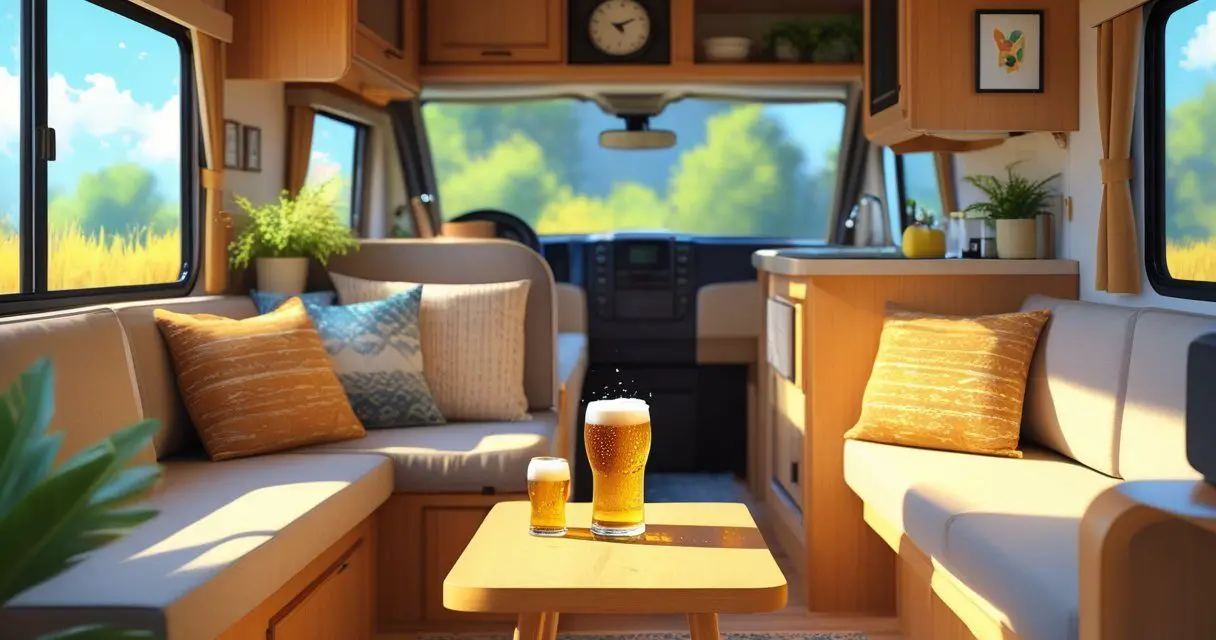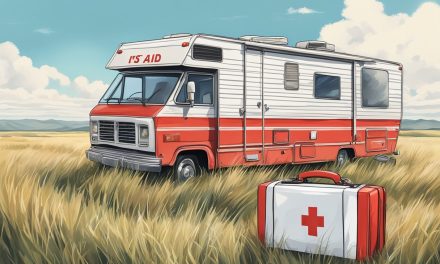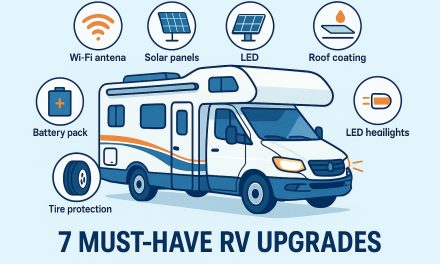Would you like to save this article?
Taking a road trip in an RV can feel like the best mix of travel and comfort. You have the freedom of the open road and the convenience of a home on wheels.
But when it comes to alcohol, the rules aren’t always simple. In some states, you can drink in the living area of a moving RV, while in others, it’s completely illegal.
The law depends on how each state defines the “passenger area” and whether the living quarters count as separate from the driver’s cab. Some states allow passengers to enjoy a drink in the back, while others treat the entire RV as one compartment with no exceptions.
That means your trip could be legal in one state and against the law in the next. Because the consequences can include fines or other penalties, it’s important to know the rules before you hit the road.
Understanding the differences will help you avoid problems and enjoy your trip with peace of mind.
Key Takeaways
- Drinking rules in RVs depend on state laws.
- Some states allow alcohol in the living area, others ban it entirely.
- Breaking the law can lead to fines or other penalties.
Can Passengers Drink Alcohol in a Moving RV?
Whether you can drink alcohol in a moving RV depends on state open container laws, how the law defines the vehicle’s interior, and whether you are in the driver’s area or the living quarters. The rules vary widely, so what is legal in one state may be illegal in another.
Key Factors Influencing Legality
Open container laws are the main factor in deciding if drinking in a moving RV is legal. These laws prohibit open alcohol containers in the passenger area of a vehicle, but states define “passenger area” differently when it comes to RVs.
Some states, such as Texas, Missouri, and Montana, make exceptions for the living quarters of a motorhome. In these places, passengers can drink if they stay out of the cab.
Other states, including Alaska, treat the entire RV as one passenger compartment. In those states, no one inside the RV can have open alcohol while it’s moving.
The rules also change if you are parked. Once the RV is off the road, alcohol use usually follows campground or property rules rather than traffic laws.
Driver Versus Passenger Restrictions
The driver of an RV can never consume alcohol while operating the vehicle. This rule is universal across all states and applies even if passengers are legally allowed to drink in the back.
For passengers, the situation depends on location. In certain states, you may drink in the living area, but you must be at least 21 years old and remain away from the driver’s seat.
Some states allow passengers in any type of vehicle to drink, while others ban it completely. Because of this, you should always check the specific laws of the state you are traveling through before opening a drink.
If a passenger drinks in a state where it’s not allowed, both fines and open container violations can result.
Living Area Versus Driver’s Compartment
The most important distinction is between the driver’s compartment and the living area. Laws that allow drinking in RVs usually separate these two spaces.
The driver’s cab is always considered part of the passenger area, so no alcohol can be open or consumed there. This includes the front seats and any space within reach of the driver.
The living quarters, which include the kitchen, bathroom, and sleeping area, may be exempt from open container laws in some states. If your state recognizes this separation, passengers can drink in these areas as long as the alcohol stays out of the cab.
Think of it like a party bus: the driver must remain sober, but passengers in the back may legally consume alcohol if state law permits.
Understanding Open Container Laws
Open container laws control where people can keep or drink alcohol in vehicles. These rules affect both drivers and passengers and apply differently depending on whether you are in a car, truck, or RV.
What Are Open Container Laws?
Open container laws make it illegal to have open or unsealed alcohol containers in certain parts of a vehicle. An open container can be a bottle, can, cup, or flask that has been opened, has a broken seal, or has some alcohol missing.
Most states ban open alcohol containers in the driver and passenger areas of a moving vehicle. This means you cannot drink or even store a partly used bottle of alcohol within reach of anyone in the seating area.
These laws aim to reduce drunk driving by removing easy access to alcohol while a vehicle is in motion. They apply whether or not the driver has been drinking.
Even if only a passenger is drinking, both the driver and passenger can face penalties in many states.
How Open Container Laws Apply to RVs
RVs are unique because they function as both vehicles and living spaces. When the RV is moving, open container laws usually treat it the same as a car or truck.
This means no one can legally drink alcohol in the driver or passenger areas while the RV is on the road. However, some states allow exceptions for areas of the RV that are considered separate from the driver’s compartment.
For example, a closed-off living space in the back of a motorhome might be treated differently than the cab area. If your RV has a kitchen, bedroom, or lounge area that is physically separated from the driver’s seat, some states may allow passengers to drink there.
But this is not universal, and in many states, open alcohol containers anywhere in the RV are still illegal while driving.
State and Local Law Variations
Open container laws are state-specific, and in some cases, local governments add extra rules. For example:
- Strict states: Many states ban open alcohol containers anywhere in a moving RV, regardless of where passengers sit.
- Lenient states: A few states allow passengers to drink in the living quarters of a motorhome if it is separate from the cab.
- Special cases: Some states have exceptions for commercial buses or limousines, but these usually do not apply to private RVs.
Because the rules vary, you need to check the exact law in the state where you are traveling. What is legal in one state may result in fines or citations in another.
This makes it important to research before crossing state lines with open alcohol containers in your RV.
State-by-State Differences for Alcohol in RVs
Rules for alcohol in RVs change depending on where you travel. Some states leave more room for passengers to drink in the living area, while others apply strict open container laws to the entire vehicle.
States With No Statewide Open Container Laws
A few states do not have a general open container law. Mississippi is the most notable example.
In this state, passengers can legally have and drink from open containers in a moving RV, though the driver must still remain sober. Other states, such as Missouri and Montana, allow passengers to drink in the living quarters of an RV.
These states treat the rear of the motorhome differently from the driver’s cab, which means passengers can legally consume alcohol if they stay in the designated area.
Some states, like Connecticut and Rhode Island, also allow passengers to drink alcohol in moving vehicles more broadly. Because of this, RV passengers in these states may drink legally whether they are in the rear living quarters or other passenger seats.
In these states, you have more flexibility, but you should still confirm local rules since city or county ordinances may add restrictions.
States With Strict Open Container Enforcement
Many states enforce open container laws across the entire interior of a moving RV. In these places, the law does not separate the driver’s cab from the living quarters.
For example, Alaska treats the entire RV as a passenger compartment. This means passengers cannot drink anywhere inside while the RV moves on a public road.
Any open alcohol container must be stored in a locked compartment or area not accessible while driving. Wisconsin follows a similar approach.
Even if you sit in the rear living area, you cannot legally drink while the vehicle is moving. The same applies in most states that adopt strict enforcement, where open container violations can lead to fines or misdemeanor charges.
In these states, alcohol must be sealed and stored properly until you reach a legal location to drink, such as a parked RV in a campground.
Motorized Versus Towable RVs: Legal Distinctions
The rules for alcohol in an RV depend on whether the vehicle is motorized or towable. Laws often treat the living space of a motorhome differently than a trailer being pulled by another vehicle.
Motorhomes and Passenger Alcohol Use
In a motorhome, the main legal concern is how your state defines the passenger area. Many states allow passengers to drink alcohol in the living quarters if those spaces are separated from the driver’s cab.
This usually applies when the RV has a kitchen, bathroom, or sleeping area. However, not all states make this distinction.
Some consider the entire motorhome—including the living area—part of the passenger compartment. In those states, any open alcohol container inside the RV while driving is prohibited.
A few states, such as Texas, Missouri, and Montana, specifically permit alcohol in the living quarters as long as it stays out of the cab. In contrast, states like Alaska apply open container laws to the entire vehicle.
Because of these differences, you need to check your state’s statutes before allowing passengers to drink.
Towable RVs and Alcohol Storage
Towable RVs, such as fifth wheels and travel trailers, follow different rules because passengers cannot legally ride in most of them while they are moving.
Since no one should be inside, drinking alcohol in a moving towable is not an option. The main issue becomes storage.
Open alcohol containers must be kept in a secure space that is not accessible from the towing vehicle. For example, you should place bottles or cans in the trailer’s refrigerator or cabinets rather than the truck cab.
If you leave open containers in the towing vehicle, you risk violating open container laws. Keeping all alcohol sealed or stored in the trailer avoids this problem and keeps you compliant with state regulations.
Safety Considerations for Drinking in a Moving RV
Drinking in a moving RV raises both legal and safety concerns. Even if state laws permit passengers to consume alcohol, you should think carefully about how it affects awareness, balance, and the overall environment inside the vehicle.
Risks of Passenger Alcohol Consumption
Alcohol lowers coordination and judgment. In a moving RV, this can increase the chance of falls, spills, or accidents when passengers move around.
RVs often have sharp turns, sudden stops, and uneven road surfaces that make it harder to stay steady. If you drink while riding, you may also distract the driver.
Loud conversations, dropped bottles, or requests to stop suddenly can create unsafe driving conditions. Even if you are not in the driver’s seat, your actions can influence the safety of everyone inside the RV.
Another risk is compliance with open container laws. In some states, passengers may legally drink, while in others, even holding an open container can result in fines.
If alcohol is within reach of the driver, police may assume the driver has been drinking, which can lead to legal trouble.
Best Practices for Safe Travel
If you choose to allow alcohol in a moving RV, set clear rules. Keep drinks away from the driver’s area and avoid giving alcohol to passengers in the front seats.
Make sure all containers stay secure to prevent spills or rolling bottles. Encourage passengers to remain seated while the RV is moving.
Standing or walking with a drink in hand increases the chance of falls. Use seat belts when available since alcohol can slow reaction time in the event of sudden braking.
Store extra alcohol in sealed containers in cabinets or the refrigerator. This reduces confusion about what is being consumed and helps meet state requirements.
If you travel across state lines, research local open container laws in advance to avoid unexpected violations.
Penalties and Legal Consequences
If you allow alcohol in a moving RV, the main risks come from open container laws and the possibility of DUI-related charges. Violations can lead to fines, license penalties, or even arrest, depending on how the alcohol is stored and who is consuming it.
DUI and Open Container Violations
You cannot drink alcohol as the driver of an RV under any circumstance. Even if only passengers are drinking, you can still face problems if an open container is within reach of the driver’s area.
Most states define the “passenger area” broadly, which often includes the entire interior of the RV. If your state does not separate the cab from the living quarters, any open container inside the vehicle can result in a citation.
Key points to know:
- Driver consumption is always illegal.
- Open containers in the cab create liability, even if unopened alcohol is legal to transport.
- Some states exempt the living quarters, but not all.
If police stop you and find an open alcohol container in a restricted area, you may receive a misdemeanor charge. This can stay on your record and affect future travel or insurance costs.
Fines, Arrests, and License Suspension
Penalties vary by state, but fines are the most common consequence. These can range from $100 to over $500 for a first offense.
Repeat violations often carry higher fines and possible jail time. If an officer believes alcohol use has impaired the driver, charges can escalate to DUI.
A DUI can result in arrest, immediate license suspension, and long-term consequences such as mandatory education programs.
Possible outcomes include:
- Monetary fines
- Arrest and court appearance
- Suspension or revocation of your driver’s license
- Higher insurance premiums
Even if you are only a passenger, being cited for an open container violation can still lead to a criminal record.
Tips for Compliance and Responsible Alcohol Use in RVs
You need to understand both the legal rules and the practical steps to avoid problems. Laws differ by state, and alcohol use in a moving RV can create risks if you are not careful about where and how it is consumed.
How to Stay Within the Law
Open container laws are the most important factor when drinking in a moving RV. Some states allow passengers to drink in the living quarters, while others ban alcohol in any part of the vehicle.
You should always check the specific law in the state you are traveling through. Keep alcohol in sealed containers unless you are in a state that permits open containers in the RV’s living space.
If you are unsure, store all alcohol in cabinets, the refrigerator, or another area not accessible while driving. Remember that the driver can never drink, and open containers must stay out of the cab.
Even in states that allow drinking in the rear of the RV, the open container cannot be within reach of the driver.
A simple way to avoid violations is to create a checklist before travel:
- Confirm state laws before crossing borders.
- Separate alcohol from the driver’s area.
- Store open containers securely when not in use.
Guidelines for Responsible Drinking
Even if drinking in a moving RV is legal where you are, you should set limits to keep the trip safe. Drinking too much can lead to disruptive behavior, accidents inside the RV, or conflicts with other passengers.
Pace yourself by drinking slowly and alternating with water. This helps prevent overconsumption during long trips.
Avoid drinking games or activities that encourage rapid intake.
Respect campground or park rules if you plan to continue drinking once stopped. Some parks restrict alcohol to private campsites or ban it in public areas.
Plan ahead for storage and cleanup. Use spill-proof cups and keep trash bags handy for bottles and cans.
This prevents messes that can distract the driver or create hazards inside the RV.





